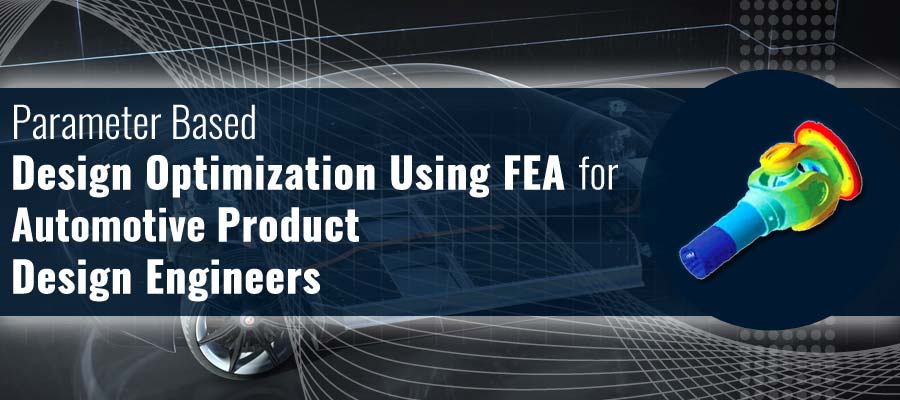From Our Blog
Posted by Jaydeep Chauhan on January 25, 2017

Design optimization essentially aims at improving product efficiency while making optimal utilization of resources. However, the optimization process is often time-consuming, especially while dealing with large data sets. Design engineers often face it challenging in delivering results due to the time utilized in analyzing large data sets. Analyzing and optimizing each data set manually, a common practice in iterative optimization approach consumes time in leaps.
In the automotive industry, power consumption and performance-based optimization is of prime importance while working on design development. Say for instance, while designing the powertrain, a design engineer has to have multiple design inputs and critical parameters to be verified and optimized for NVH, mass reduction as well as structural strength. Usually, this involves several calculations and selecting data from large sets for design parameters, which is often iterative in nature. As an alternative to iterative design optimization approach, parameter based design optimization approach helps the design engineer to reduce the time and efforts required in coming up with an optimal and efficient product design.
While dealing with large design datasets, it is often confusing to select the best solution from numerous possibilities. This is exactly where parameter based optimization stands out to assist you in selecting the best topology for the component that you’ve designed. It allows you to pick the best solution from the available options of designs.
Several advanced techniques such as approximations, Design for Six Sigma (DFSS), and Designs of Experiments (DOE) that comes with parameter-based optimization, sets the wider scope of designing and exploration. Another excellent feature of parameter based design is that it allows you to view designs from multiple viewpoints, an essential in taking critical decisions with rising design complexity while dealing with NVH. Detailed analysis of gear teeth contact and other power transmission elements across the power train draws a picture of durability with which NVH behavior can be optimized. This approach on a whole also empowers the automotive product manufacturer to assess the analysis results and implement a better solution.
Designing a sturdy structure, appropriate to absorb vibrations during the power transmission, is equally important as managing and reducing the vibrations themselves. An optimized structural design obtained from testing several data sets is the most reliable and complies with the assembly. It develops insights for changes in frozen areas at the boundary conditions and allows you to understand design tradeoffs effectively. Through structural analysis, the analytical prediction of stress and load capacity across the powertrain assembly is possible and it provides the direction to make appropriate changes. However, this is equally true for traditional optimization process, but analyzing the structure of every single component in the assembly becomes cumbersome.
Other than NVH and structural analysis, another important factor for automotive design industry involves constant efforts to reduce the mass for increased performance. Topology analysis for designing new innovative shapes complements the performance and predicts layout of structural and mechanical systems. Topological design parameters are selected to have optimized material distribution over the entire topology of the powertrain, for a given set of loads and constraints within a given design space. It analyzes and eliminates the features that do not contribute to the structural behavior of the product, thereby reducing the manufacturing costs.
Parameter based optimization software are also equipped with standalone optimization tools, delivering non-linear FEA results for customized parts. Such tools can easily be clubbed with commercially available FEA software like ANSYS, SIMULIA Abaqus etc. to harness their best outcomes without interoperability issues. Parameter based optimization goes to the lengths of including material properties with accurate geometric details, in order to deliver exact end results that replicate real world conditions.
Selection of correct optimization technique for any component relies heavily on factors like cost, time and the intended application of the component. These optimized results when obtained through experts deliver accurate analysis and develops insights for future decisions based on design. An experienced professional has a better perception of analysis results and can direct the entire team of design engineers to deliver the best possible component. FEA expertise, when clubbed with parametric based optimization approach, delivers incredibly scalable results within minimal time. The exciting part of parameter based optimization is it automates the task of defining design parameters by selecting the best from the huge available data sets. This reduces the effort and time consumed in analyzing the data and filtering to set the order for optimization tests.
Employing proper technique of optimization is of vital importance when there is a large data set for design inputs and variations. Automated design parameter based optimization comes in for the best possible assistance to the designer when dealing with multiple complex design options. Such advanced optimization tools reduces the time taken for design development and shortens the costly design processes reducing the overall resources input. It essentially minimizes the efforts for product design validation and ensures performance safety of the component.
About Author: Jaydeep Chauhan is an Engineering Specialist working at Mechanical 3D Modelling for the past 1 year. He caters critical engineering challenges with ease and performs exhaustive procedures to develop robust, well-engineered and high performance designs. He can always be found in the lab discussing, brainstorming and tweaking designs.